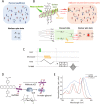Singlet fission as a polarized spin generator for dynamic nuclear polarization
- PMID: 36859419
- PMCID: PMC9977948
- DOI: 10.1038/s41467-023-36698-4
Singlet fission as a polarized spin generator for dynamic nuclear polarization
Abstract
Singlet fission (SF), converting a singlet excited state into a spin-correlated triplet-pair state, is an effective way to generate a spin quintet state in organic materials. Although its application to photovoltaics as an exciton multiplier has been extensively studied, the use of its unique spin degree of freedom has been largely unexplored. Here, we demonstrate that the spin polarization of the quintet multiexcitons generated by SF improves the sensitivity of magnetic resonance of water molecules through dynamic nuclear polarization (DNP). We form supramolecular assemblies of a few pentacene chromophores and use SF-born quintet spins to achieve DNP of water-glycerol, the most basic biological matrix, as evidenced by the dependence of nuclear polarization enhancement on magnetic field and microwave power. Our demonstration opens a use of SF as a polarized spin generator in bio-quantum technology.
© 2023. The Author(s).
Conflict of interest statement
The authors declare no competing interests.
Figures





References
-
- Baldo MA, et al. Highly efficient phosphorescent emission fromorganic electroluminescent devices. Nature. 1998;395:151–154. doi: 10.1038/25954. - DOI
Grants and funding
LinkOut - more resources
Full Text Sources

